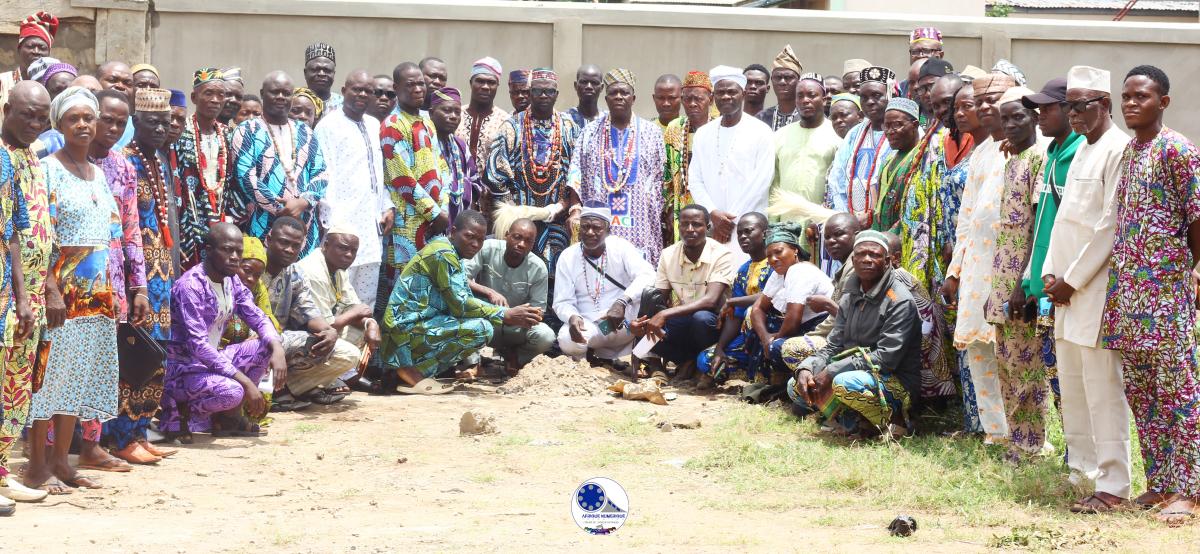Bridging Indigenous and Western knowledge systems for inclusive forest-based resilience in Benin
Bridging Indigenous and Western knowledge systems for inclusive forest-based resilience in Benin
Rooted in cultural and spiritual traditions, sacred forests offer unique opportunities for conservation. This feature article by Edmond Totin, Esdras Obossou, and Ferdinand Ayimasse highlights the Knowledge-to-Action (K2A) project in Benin, led by the NGO SURVIE de la Mère et de l’Enfant. The K2A initiative aims to integrate Indigenous Knowledge and sacred forest management into biodiversity and climate policies across six districts.
The latest IPCC Sixth Assessment Report emphasised that diversity of Indigenous and local knowledge systems provides a rich foundation for adaptation actions at local scales. Mainstreaming these knowledge systems in adaptation policies and practice is essential for equitable and effective local climate solutions. In Benin, the local NGO, SURVIE de la Mère et de l'Enfant, in partnership with the Climate and Development Knowledge Network (CDKN), is contributing to this crucial climate action through the Knowledge-to-Action (K2A) project themed "Revaluing biodiversity by leveraging African traditional knowledge in Central Benin".
The initiative is being carried out across six administrative districts in Benin: Dassa-Zoumè, Savè, Savalou, Bantè, Ouèssè, and Glazoué. It builds on knowledge co-production approaches to develop solutions that respect cultural heritage and strengthen community resilience in biodiversity conservation. It seeks to establish alliances among scientists, local leaders, and community members, including youth and women's groups, to integrate Indigenous knowledge into subnational forest management plans and policies. The Knowledge-to-Action (K2A) initiative builds on experience from sacred forest management to promote natural resource conservation.
Sacred forests hold cultural and spiritual values and are ecologically important. Although they were not initially planned for biodiversity conservation, the deep-rooted socio-cultural connection between ancestral spirits and people living around these forests has long contributed to protecting these ecosystems. These ecosystems are habitats for vulnerable natural species and serve as biodiversity reservoirs in challenging climate conditions. In many parts of the country, sacred forests are used for specific rituals, ceremonies, or traditional practices, enriching cultural beliefs. Because of the interconnectedness of sacred forests with people’s culture and belief systems, they remain successful conservation strategies against the unsustainable use of natural resources with urbanisation and growing food demand. Given their ecological and cultural significance, integrating sacred forests and the associated Indigenous Knowledge into environmental and climate adaptation strategies is critical.
Indigenous Knowledge (IK) represents centuries of accumulated wisdom deeply intertwined with the natural environment. It has demonstrated effectiveness in managing ecosystems that support long-term sustainability. Incorporating IK into biodiversity strategies is not only a recognition of its importance. It also safeguards cultural heritage, empowers communities, and ensures local experiences and practices contribute to a global approach to climate adaptation.
Sacred forests and Ecosystem-based Adaptation in Benin
In the context of Benin, forests in the state domain are either classified or protected. Classified Forests are those subject to a restrictive regime of usage rights. Protected Forests refer to other state forests that have not been classified, including sacred forests. Unlike classified forests protected by conventional regulatory policies and laws, sacred forests in Benin are protected through traditional taboos embedded into indigenous people’s culture and belief systems. Interestingly, studies revealed that sacred forests in Benin harbor high levels of biodiversity, often exceeding that of state-classified forests, due to strict local taboos that drive behavior at both intrapersonal and interpersonal levels and thus prevent illegal forest activities. As a result, Sacred forests serve as natural refuges for endangered species (e.g. pollinators, wild medicinal plants, and crop wild relatives), protect carbon sinks, and help maintain the regulation of the water cycle. They play a crucial role in soil fertility maintenance, water retention, and microclimate regulation, making them critical assets for local climate resilience. Additionally, their co-occurrence in populated rural and urban areas creates equitable access by ensuring that local communities retain control over their natural resources.
Stakeholder mapping and engagement
Survie’s advocacy focuses on biodiversity conservation by promoting species linked to deities (e.g., Sakpata, god of the earth and smallpox; Hevioso, god of thunder and justice; Ogou, god of iron and warriors, etc.). The NGO also mapped Indigenous stakeholders across the K2A project areas.
Key interventions involved engaging local authorities through grassroots consultations with chiefs and elders. The goal is to ensure that sacred forests are recognised as vital to the local environmental and cultural landscape. As one of the local chiefs noted during a meeting, “We understand the importance of protecting sacred forests. The knowledge from our ancestors has value beyond our local villages; it can be part of the global effort to protect nature.”
Engagement efforts sought to persuade local leaders that sacred forests enhance regional biodiversity. However, despite positive feedback about the initiative, challenges emerged in converting discourses into action, given the daily problems community leaders face. One administrative officer stated, “The conversation about sacred forests is important, but our resources are limited. We can’t pursue every initiative, even if we agree.” This demonstrates how, sometimes, what feels right ideologically is not always feasible due to the realities of subsistence and livelihood needs.
At the community level, various campaigns by the local NGO acknowledged the spiritual, medicinal, and ecological values of sacred forests. One community member, a woman leader from Glazoué, expressed the importance of intergenerational learning: “I want my children to learn how to protect our sacred forests, just as my grandparents taught me. These forests are not only for us today but for future generations... We have seen the plants and are now planting them in the forest. These sacred trees represent our culture and our heritage identity”. Through these community campaigns, the project has fostered a sense of ownership over the forests and empowered local people to become the primary stewards of these sites.

Key Achievements
The project has achieved success in raising awareness among authorities and community members.
Successful advocacy efforts in integrating indigenous biodiversity-friendly practices into biodiversity policies and strategies
A key achievement was the successful advocacy efforts of the project for the inclusion of indigenous knowledge and practices related to sacred forests into biodiversity conservation policies and strategies. Targeted meetings with local authorities highlighted the importance of sacred forests as cultural and ecological assets. As a result, certain municipalities are considering mainstreaming sacred forest management systems into their environmental strategies, particularly in the District Development Plans. This is a crucial step toward securing formal protection for these forests.
One local policy-maker explained, “[...] We are now beginning to realise the importance of preserving sacred forests not only for the people but also for the health of our entire region. [In the context of Benin], our modern approach to conservation must integrate Indigenous wisdom to be truly effective. We can invest in infrastructure, build schools, or support women's groups, but without a healthy environment, these efforts will be in vain.”
The project’s success in bringing sacred forests into the discourse around formal biodiversity conservation planning is a powerful demonstration of how integrating Indigenous knowledge into policy can help bridge gaps between traditional and modern environmental governance.

Increased awareness and buy-in from local leaders
Another key achievement was the increased buy-in from local leaders and Indigenous people, including village chiefs, elders, deity priests, crowned heads, religious dignitaries, and community representatives. These local stakeholders are critical in shaping community behaviour and enforcing local regulations. Their commitment was shown in their support for sacred forest protection against illegal exploitation of flora and fauna resources and promoting the initiative within their communities. One village chief commented, “The forests are sacred to us. We know they must be protected. Now, I will encourage my people to act, not only because it’s our tradition but also because it is the right thing to do for the future of our land.”
Challenges
While the project has achieved significant milestones, it has also faced several challenges.
Limited resources for sustained advocacy
A major challenge is the limited resources available to support long-term advocacy initiatives. Although there was initial enthusiasm and success in engaging local communities and authorities, the local NGO is struggling to maintain momentum. Budget challenges have led to reduced outreach activities, limiting the scope of the campaigns and leaving some communities less engaged.
Limited commitment of local authorities
Another obstacle was the limited buy-in from certain local authorities, especially at the district level. Even though discussions were encouraging, tangible actions - issuing administrative notes or formalising commitments - were frequently postponed or incomplete. For many, reconciling long-term adaptation goals with immediate responsibilities - providing services, maintaining infrastructure, or responding to political pressures - has proved challenging. As politically elected officials, their willingness to commit is often influenced by whether an initiative aligns with short-term political agendas or electoral cycles.
Lessons learned
Several lessons from the project’s experience have emerged, informing future advocacy efforts.
Scaling advocacy efforts regionally
To scale up advocacy efforts, expanding partnerships with institutions that focus on biodiversity conservation, climate resilience, and indigenous rights will provide leverage and accelerate the project's reach. Regional networks can also serve as platforms for sharing knowledge and best practices. One local leader explained, “If this initiative is replicated throughout the region, we will gain a stronger voice in advocating for the protection of forests.”
Improving local authorities’ accountability
Enhancing accountability among local authorities is essential for the project's long-term success. Implementing transparent reporting, monitoring, and follow-up to hold authorities accountable would empower local communities to take ownership of the project's legacy. The continuous involvement of local authorities in project design and implementation will also promote a greater sense of responsibility and ownership.
